Volkswagen e-Golf – long-term test: is the family hatchback still one of the best when it’s electrified?
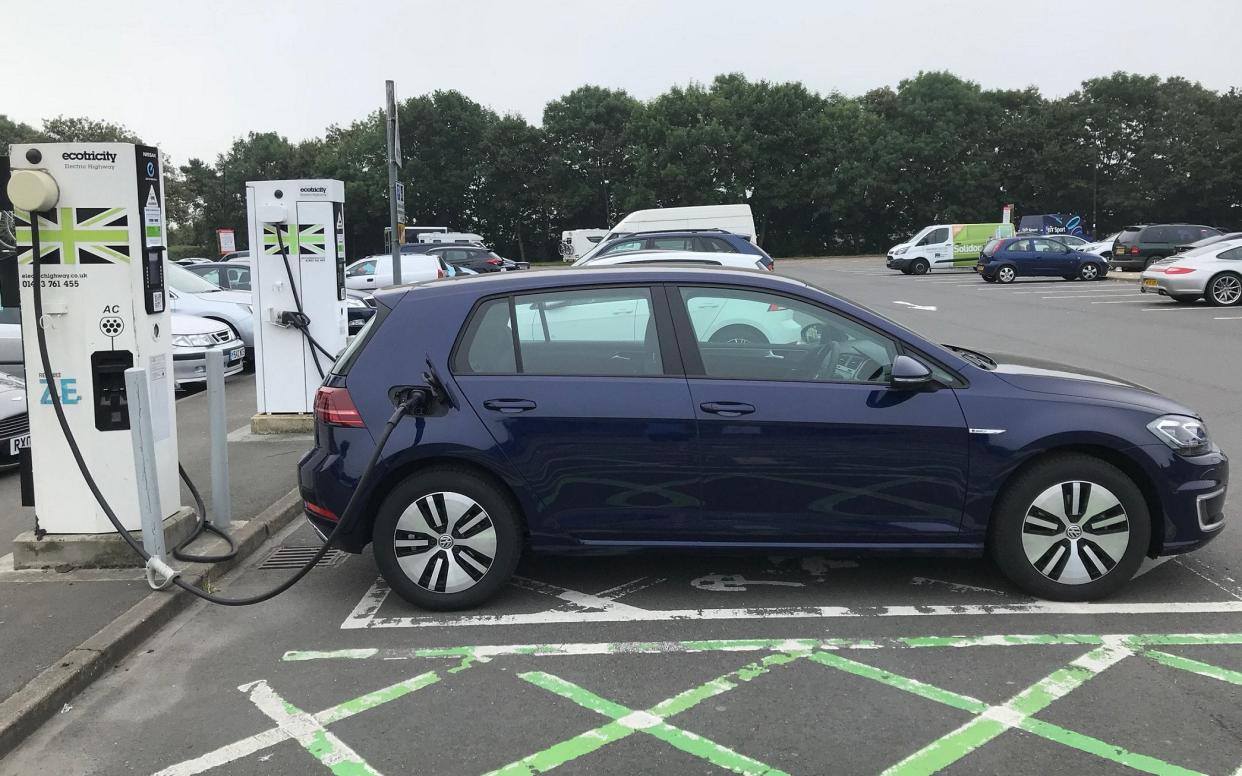
It is fair to say that the regular Volkswagen Golf is one of the best all-round buys – competitively priced when new and holding its value well. Does ditching an internal combustion engine make it a better day-to-day bet than a bespoke electric car?
Our car: Volkswagen e-Golf List price when new: £32,730 (excluding PICG grant) Price as tested: £35,490 (excluding PICG grant) Official fuel economy: n/a
November 27, 2018
Average consumption: 4.3 miles/kWh
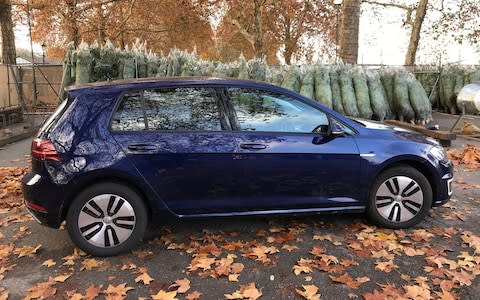
After six months with the e-Golf it’s time to say farewell. It has been a highly enjoyable experience overall – and, more than that, a very useful one, as it has provided a valuable insight into what EV ownership is like today.
EV ownership or usership will be very common in a decade’s time – and the norm by 2040 – so running an e-Golf has been very instructive in seeing what the barriers to take-up currently are and what more can be done by carmakers and infrastructure providers to help make electric vehicles more practical as day-to-day conveyances.
Let’s start with manufacturers. Volkswagen has done a fine job of producing a useful, easy-to-drive, comfortable car that is a joy to use in urban situations. It helps that the Golf is a highly popular car (for good reason: it’s a highly accomplished family hatchback), so the familiarity helps with the transition to electric motoring.
Above and beyond that, the addition of an almost-silent driving experience, which is very relaxing, plus the ability to out-sprint almost any other car on the road over the first 100m adds further reasons for urban customers to consider the e-Golf.
But… the e-Golf, in common with most of the EVs on the market, doesn’t have a huge range (I managed about 150 miles once, with very careful battery management – ie slow driving – but around 100-120 is more realistic), so longer trips are tricky. However, it's early days yet and, if the Hyundai Kona Electric is anything to go by, that range anxiety can be overcome in the next few years. That should be primary goal for carmakers.
Yes, most drivers don’t need to cover huge distances and, in the future, hydrogen fuel-cell vehicles will be better suited to that kind of use, but offering a realistic 300-mile range would make EVs more rounded and practical, and eliminate the biggest barrier to consumer uptake.
As an aside, if Volkswagen’s Car-Net is any guide, the manufacturers also need to get some better app developers. When it works, Car-Net is very useful: when it doesn’t – and that’s more frequent than it should be – it’s highly annoying and tarnishes the ownership experience.
Moving on to the infrastructure providers, they need to do a lot more to make public chargers cheaper, more available and more reliable. It’s not Volkswagen’s fault that charging the e-Golf was often frustrating, but it is a factor in recommending whether buyers should spend their hard-earned on the electric version, as opposed to 1.5 TSI Evo petrol or 2.0 TDI diesel variants.
I live in a terraced house, which means a home charger isn’t a possibility for me, sadly – because that is by far the cheapest way to run an EV. As one of the 30 per cent of UK householders who don’t have access to a garage, drive or carport, I’ve had to rely on public chargers. Luckily, I’m relatively close to a bank of three chargers run by Source London, so it’s not been a huge chore to get the e-Golf charged whenever I need to.
However, the cost of electricity is two to three times what it would be on a domestic tariff, which is galling (although I realise that charging providers also have the cost of installing chargers, corporate overheads, etc). And while I’ve had no technical problems with Source London chargers (apart from the fact that their app is next to useless), I experienced card problems with Chargemaster and, worse still, the reliability of Ecotricity chargers on the motorway network is utterly appalling – to the extent that I was at risk of being left stranded on more than one occasion.
The rollout of chargers is tricky at the moment: we’re definitely in the realm of chickens and eggs. But if the providers can at least ensure that existing chargers actually work reliably, it would make EV ownership a much more practical proposition.
That said, if you rely on public chargers, even with a wallet full of cards and a smartphone loaded with apps such as Zap-Map, life can be a tad awkward at times – but that’s still not enough to diminish the experience of running an e-Golf. It really is just like having a Golf, but cheaper (even electricity from public chargers halves fuel costs), more reliable (fewer moving parts, so less to go wrong), cleaner for the environment (important in London, with its poor air quality) and offering a taste of the future that awaits all of us (who doesn’t like the feeling of being ahead of the game?).
The big question is, though, would I buy one with my own money? The answer has to be yes – a qualified yes, for the reasons I’ve detailed here, but a yes all the same. The e-Golf has convinced me that electric motoring is the future, especially if you live in a city.
I’m certainly sad to see ‘my’ e-Golf go. As the song goes, I heave a sigh and say goodbye.
November 20, 2018
Average consumption: 3.9 miles/kWh

As the end of my time with the e-Golf approaches, I’ve started to think about the experience of ownership in general terms, and the specific pros and cons of EVs.
The e-Golf itself is hard to fault, especially in terms of its use in urban environments. It’s quiet, nippy, easy to use, comfortable and well equipped: it could benefit from a bigger battery pack to give it another 100 miles or so of range, but that will come with electric Volkswagens in the next few years.
The other thing that isn’t quite ready is some of the technology surrounding ownership.
I’ve written before about my problems with the Volkswagen Car-Net app and, sadly, they continue. I charged the e-Golf at the weekend, but when I went to the app to try and check on the charging status, my account was logged out and I couldn’t log back in because the app couldn’t connect with the server.
This is irritating enough in itself, as it meant I had to guess when the car was fully charged, rather than knowing exactly. However, as I’m using Source London public chargers, the cost of which continues to rack up as long as you’re plugged in, even if the car has reached its maximum charging capacity, it’s crucial that owners can access an app that tells them the state of charge at all times.
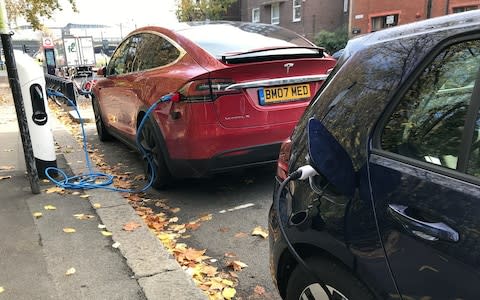
The Car-Net app is the only option in my case, because Source London doesn’t have an app of its own that is functional, in any 21st century way at least. It has a page dedicated to a map of its chargers - but without any information on their current status - another page for one’s account information, with a third offering information on the company, some FAQs and contact details.
There’s nothing interactive about it, you can’t use it to start or end a charging session and you can’t add credit to your account.
And this is the company with responsibility for most of the public charging network in Europe’s biggest city, the natural location for the growth of the market for EVs such as the e-Golf. It doesn’t bode well for investment in that network over the next few years and what owners can expect to experience.
The e-Golf returns to Volkswagen next week and I will miss it - but I won’t miss some of the EV teething problems.
November 13, 2018
Average consumption: 4.3 miles/kWh
This week, I thought I’d highlight two aspects of the e-Golf that have particularly caught my attention – one electrical, one mechanical.
The electrical has – perhaps surprisingly, for an electric vehicle – nothing to do with the e-Golf’s powertrain. No, what I’ve been particularly struck by, as the clocks have gone back and the nights have closed in, is the lighting system.
All e-Golfs, unlike regular Golfs, have LED headlights and C-shaped daytime running lights (DRLs) – and they’re very bright. LED lights are becoming increasingly commonplace on modern cars, filtering down model ranges and from premium marques to be found on mainstream cars.

Their greater brightness (compared with xenon lights) is a valuable safety feature, allowing a car to be seen from a greater distance and enabling the driver to see further ahead. In addition, they use less power than xenon lights, so are more efficient – an advantage for all cars, but a definite boon to an EV, where you want as much of the electrical energy as possible assigned to powering the car.
It’s noticeable how much brighter the e-Golf’s LED lights compared with those of oncoming cars and, allied to the DRLs, they improve the face of the car.
However – and readers with cars equipped with LEDs might also have noticed this phenomenon – other road users aren’t quite aware of the power of this latest evolution of automotive lighting and I’ve been flashed a few times by drivers who think that my lights are on full beam. No doubt this will continue as LEDs work their way through to every new car in the next few years.
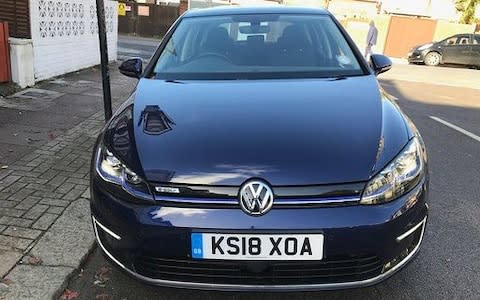
The mechanical aspect of the e-Golf is something that I’ve noticed for a while now. Its quietness is definitely one of its major advantages and something that I really miss when driving cars with internal combustion engines, however refined they are.
But EVs are still mechanical vehicles, which you're reminded of when the car is cold and you can hear the creaking of the steering and the brakes. It’s not that loud, but it is noticeable when there's no internal combustion engine to mask it.
The e-Golf definitely represents progress, but there’s still a reminder that in many ways it’s still the kind of car that we’re used to.
November 7, 2018
Average consumption: 4.1 miles/kWh
It’s perhaps indicative of how little rain we’ve had since May in London that last week I noticed for the first time the shortcomings of the e-Golf’s windscreen wipers.
I lent the car to a fellow journalist in the summer and he mentioned the that the wipers weren’t great, but I thought no more about it – until last week when it started raining. The wipers are fine on the upstroke, but smear the screen on the driver’s side on the downstroke. The car is brand new, so the blades shouldn’t be worn, so I’ll try the old trick of wiping them with some vinegar to see if that works.
The weather last week also means that I can firmly debunk the myth about not charging an EV in the rain: I did so and managed to not electrocute myself, or cause the e-Golf to explode in a water-induced, short-circuiting incident.

On the subject of charging, I also found myself competing for a charger this week, the first time that it's happened while not on a motorway.
I noticed a few weeks ago that Chargemaster had installed a new unit on Trinity Road in Wandsworth (it's so new that it doesn’t feature on the company's map or the Zap Map app). I was hoping it was a 50kW rapid charger.
Unfortunately, when I went to use it, one of the capital’s new plug-in hybrid black taxis was already topping up. You can’t really condemn a working driver – one who has signed up relatively early for low-emissions cabbying – for using a charger, but it rather dented my plans.
With new figures showing that electrified vehicle sales increased 30% year-on-year on October, and now constitute 5% of all new car sales, this is an issue that will increasingly confront EV drivers. The whole chicken-and-egg situation of EVs and public chargers will continue for a while yet, so queues and the kind of "charger rage" that we saw in California recently will undoubtedly become a recognised phenomenon.
Although, unlike in sunny California, we have the British rain to help cool us off.
October 30, 2018
Average consumption: 3.2 miles/kWh
The cold weather has finally arrived, so this weekend I was able to see just what kind of effect lower temperatures can have on the battery of any electric car.
Manufacturers tend to work on the assumption that winter ranges are about two-thirds of their range in warmer weather and the short trips I made at the weekend did seem to bear this out. The projected range in the display started to fall pretty rapidly, so a five-mile trip meant the range taking a hit of eight or nine miles. A few short local trips on Saturday saw the range fall from 104 miles to 69 miles.
It’s not an exact science, however, because there’s an additional factor involved: using the heater. During the summer months, I eschewed the air-con almost completely, opting instead to keep the front windows open to get air flowing through the car.
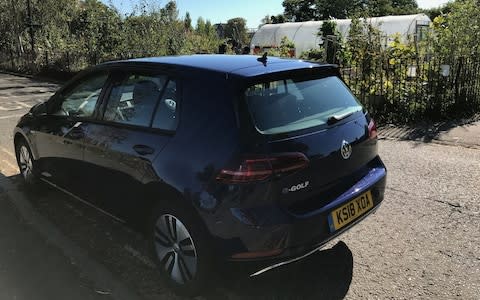
This weekend it was very much a case of switching on the heating as soon as I got in the car, so the rapid depletion of the e-Golf’s range can partly be ascribed to that, as well as the outside temperature’s effect on the battery. How much of each factor is to be blame is hard to pin down. I’ll try driving without the heating (but with a few extra layers of clothing - and gloves) this week to discover how the cold weather alone limits the range.
This lower range in cold weather is an interesting element for buyers to consider when considering purchasing an e-Golf (or any EV, for that matter). Looking at the weather forecasts on TV will highlight just how much temperatures vary across the UK. The south-east’s relatively mild climate (especially noticeable in recent winters) is very different to the north of Scotland. This weekend, for example saw differences of six degrees between the two regions and it is often greater. Summer temperatures can often even further apart.
The relatively small number of EVs on our roads at the moment means that sample size is much too low to be able to conduct proper research on range differences – with the associated related charging costs – but give it a few years and we should be able to work out the relative economic costs of running an EV in different parts of the UK. They could be significant.
October 23, 2018
Average consumption: 4.2 miles/kWh
The e-Golf continues to do its job brilliantly around town, silently performing errands and costing next to nothing while doing so. It’s the ideal urban car.
But I did have something of a mishap this weekend. Car security is something that perhaps I’ve taken for granted in the era of central locking and keyless go systems. Yes, there are scanners and signal blockers that criminals use to steal of unlock cars, but I’ve been lucky enough to have had only one incident (a break-in on a Citroen AX) in all the years I’ve owned cars and driven in London.
And I’ve loved the e-Golf’s keyless entry system (a £375 option), which I’ve found really handy. The proximity sensor has enabled me to put things in the boot without having to fish in my pocket for a key and unlock it when my hands are full. Also, if you just put your hand on the door handle, the car unlocks and you can get in and start the car without sticking the key in the steering column.
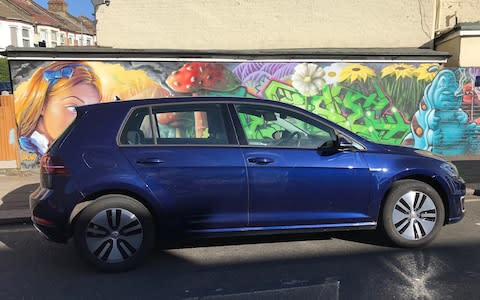
I’ve always been a bit paranoid about checking my car is locked because I tend to do it automatically without thinking about it – indeed, I frequently go back outside and lock the car using the key to make sure.
But Saturday was a long day, starting at 8am in Portugal, test driving a new BMW 8-series, flying home and then picking up my elder daughter after her shift at a local restaurant at 1am. I pressed the button on the key and locked the car as usual. At least, I’m pretty sure I did.
When I got in the car on Sunday afternoon, however, the glovebox was open, as was the little cubby next to the steering wheel and the centre console, suggesting that someone had rifled through the car. Luckily, I never keep anything in the car – apart from a pair of Ray-Ban sunglasses, which had gone. Damn.
Because I don’t take the key out of my pocket to get into the car, I have walked away from the e-Golf once or twice, thought about whether I’ve actually locked it, checked, and realised that I haven’t. This is partly because a previous long-termer, a Renault Mégane Sport Tourer, has the French brand’s card-like system, which is entirely hands-free as a default, so there’s no need to ever take it out of your pocket. It unlocks as you approach the car, locks when you walk away.
The e-Golf’s keyless go is a great feature – convenient, user-friendly, practical – but it does require the owner to not become complacent and remember that while the key isn’t required to unlock the car, it does need to be taken out to lock it.
So is it worth the extra £375? Yes, if you remember that it only unlocks the car, but perhaps makers such as Volkswagen which offer keyless systems should offer the same hands-free mode as Renault.
It will save owners having to make repeat sunglasses purchases, if nothing else.
October 17, 2018
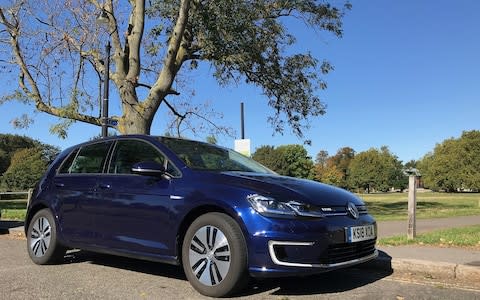
Average consumption: 4.9 miles/kWh
Five months into my loan of the e-Golf, I’m mentally drumming my fingers, waiting for the temperature to drop to see how that affects the car’s range. But, as this crazy climate continues to throw summer temperatures at us deep into October there’s still nothing to report.
However, there is one factor that affects the e-Golf’s range irrespective of temperature: hills.
A few weeks ago, driving to London from Oxfordshire, I was in a situation where the stated range in the instrument panel was just 10 miles greater than the distance to my destination, a charger at the Holiday Inn, High Wycombe. Ten miles isn’t a huge cushion when you’re driving an EV on a motorway – especially as service stations can be a lot further apart than that – but as I was heading into the higher-density south-east of England, and I knew that the Polar charger was in operation at my destination, I wasn’t overlay anxious.
And then I drove uphill.
A long inclined stretch of the M40 as it crosses the Chilterns saw the range of the e-Golf drop rapidly, even though by this point I was driving at a steady 50mph, using the cruise control, to conserve range. Suddenly, instead of my 10-mile cushion, it was suddenly two miles, which isn’t much of a margin of error. Thankfully, the road levelled out soon after, so by the time I reached the charger, I had nine miles of range.
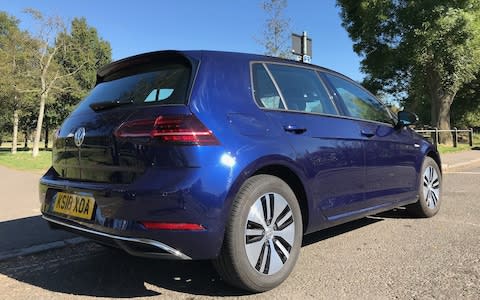
Living in an area where there are few major changes in topography, I’d not previously noticed the how going uphill affected range. But this experience caused me to reflect on how suitable an EV is in parts of the country where hills and mountains are features of a daily drive. Does living in mid-Wales, the Peak District or the Highlands make an EV impractical, because – quite apart from the absence of public chargers in these areas – range is going to be considerably lower than the manufacturer’s claims.
Of course, these rural locations are also areas of outstanding beauty, so driving a clean, zero-emissions EV is completely in keeping with the natural environment around, but going up hill and down dale could challenge expectations of how far these cars will go.
So should car owners in these areas of the country invest in an EV such as the e-Golf? If they have off-street parking (and, as a result, are able to have a charger installed at home) and their driving profile is such that they don’t tend to cover large distances on a regular basis, then an e-Golf will be cheap to run and less harmful to the environment.
Although an almost-silent car will certainly confuse any sheep straying on to the road.
October 5, 2018
Average consumption: 5.2 miles/kWh
No great adventures in the e-Golf this week, just the usual metropolitan to-ing and fro-ing, which has led to the reinforcement of one view that has been forming on my mind over the last few months.
But it was also time for some TLC in the form of a trip to my local fuel station - which, after four months in an electric car, I just about managed to remember the location of. There I ran it through the car wash, to get rid of the general dust and grime of city life (plus the paw prints of the local foxes on the bonnet) and checked the tyres.
The e-Golf had felt a little underpumped recently, especially at the front, so I consulted the sticker on the driver’s door for the correct pressure. As it turned out, all the tyres were the same pressure: all wrong, by 4psi, so a quick top-up was in order. The result wasn’t miraculous, but the ride did feel slightly better resolved, especially over the multitude of local speed humps.
The e-Golf’s quietness contributes to a sense of calm, but there is a downside - it is also a hazard to pedestrians.
As a driver, you have to be more vigilant: on that trip to the filling station, I had to brake for three people who were either crossing the road or walking into it to get into a parked vehicle. It doesn’t help that so many people these days are either wearing earphones and/or looking at their phones as they walk. Combined with this general lack of concentration, an increase in near-silent cars could result in more casualties from collisions.
It’s something that we’re all going to have to get used to as the proliferation of electric vehicles continues in the next decade and beyond.
September 26, 2018
Average consumption: 5.1 miles/kWh
After four months of living with the e-Golf, I’m more convinced than ever that electric cars are the future of motoring.
The unveiling of the Audi e-tron in San Francisco last week, along with plans from carmakers for a slew of new models being launched on to the market in the next two or three years, is proof that manufacturers are taking EVs seriously.
But that’s the future. Living with the e-Golf has also convinced me that we’re not there yet, especially when it comes to the public charging infrastructure that we will all rely on, to some extent or another. Because that just isn’t reliable enough yet.
According to forecasts, the majority of EV owners in the future will charge at home and/or at work, so problems should be minimal. However, anyone undertaking long trips, despite EVs such as the Hyundai Kona starting to have ranges of 300-plus miles, will need to rely on public networks of rapid chargers to keep them going. And they’ll need to be more reliable than they are now.
Ecotricity has a monopoly on chargers at motorway service stations and they are, currently, utterly appalling. I’ve spent quite a bit of time in my e-Golf on the motorway network in the last few weeks and of the six attempts at charging on 50kW CCS DC chargers, three have ended in failure.

That’s bad enough, but when you consider that when travelling on a motorway network there are no alternatives for many miles, you can see how important those failures are. On my recent trip to Wales, I was unable to charge for 97.5 miles on the motorway, because of failures at Membury and Cardiff Gate services.
I had the same situation last Friday, where the Ecotricity charger at Cherwell Valley services on the M40 didn’t work. With just 36 miles of charge on the car, I had to limp to High Wycombe, driving at 40mph. Arriving at a Holiday Inn that had a Polar Network unit, the message on the e-Golf’s instrument panel told me that my battery was empty (I had 9 miles of range). After charging fully, I made it home with relative ease, but my 74-mile journey took just under six hours in total.
Ecotricity told us: “The Electric Highway has high levels of reliability and works effectively more than 95 per cent of the time. We’re currently experiencing an intermittent fault with CCS charging and are working with our technology provider DBT and their partners to solve the problem.”
That’s of little comfort to EV drivers. At one point, going uphill on the M40, the difference between my range and the distance to High Wycombe was just 2.1 miles, which is an uncomfortably small margin of error – and also demonstrates the effect topography can have on EV battery levels.
The e-Golf can cope with journeys longer than its 120-140-mile range, but only if the public chargers that it relies on to top up actually work. I’ve not yet run out of charge on a motorway, but I came pretty close last week, which is enough to make me even more vigilant about having a back-up plan whenever taking long journeys.
September 18, 2018
Average consumption: 5.1 miles/kWh

I’ve been unfaithful to the e-Golf this week with a Skoda Fabia, which I drove down to Wales over the weekend (combustion being the better part of valour, after last week’s marathon). After four months in the e-Golf, having to change between six gears did initially feel strange, as I’ve become used to stick-it-in-Drive-and-go nature of the e-Golf.
That said, though, I’ve now got into the habit of not just using Drive, as I’m starting to use the full capabilities of the Volkswagen’s regenerative braking, which is proving very useful for maximising range.
Quick science bit. Regenerative braking is a system that recovers energy from the process of braking that that would be otherwise lost as heat, storing it instead as electrical energy in an EV’s batteries. When placing the e-Golf in regenerative mode (indicated by a B on the gear lever), as soon as you lift off the accelerator, the car starts to instantly slow, as opposed to coasting in Drive mode.
That engine braking at first seems a little harsh and jerky when driving the e-Golf, but you quickly learn to slowly lift off and feather the throttle. This means that you can be going downhill, still accelerating slightly but the battery is being charged: the driver can tell because the power use dial swings to the left of centre, into a green zone, as opposed to the blue on the right, which indicates how much power is being used.
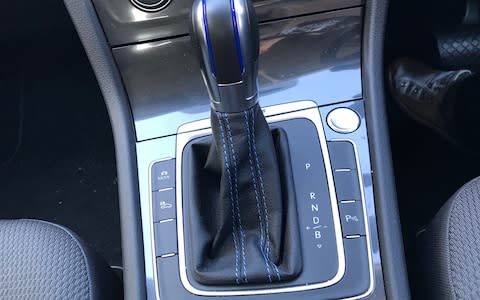
This works best in town, as the battery is being charged frequently, but once you get the hang of gently lifting off the accelerator, you can even recharge on downhill stretches of a motorway.
Of course, this extra electrical energy being transferred from the brakes means that you can regularly add little top-ups to the battery. Around town, I’ve been finding that my average consumption has increased to around 5.1 miles per kWh, as opposed to somewhere between 4.2 and 4.6 miles per kWh. Even on the 200-mile journey to Wales last week, driving at a steady 65mph and using the regen braking, I was still able to record 4.3 miles per kWh.
And, with very little practice, driving in stop-start traffic can be undertaken largely using just one pedal, the accelerator. Anticipating the flow of the traffic by watching brake lights of cars a few vehicles ahead means that you can often make short journeys with little impact on the range displayed in the car.
So in urban environments, not only is the e-Golf not emitting any tailpipe emissions, but it’s also using negligible amounts of energy. Along with the calm, silent running of the car and the available short-distance performance, the advantages of driving an EV continue to add up.
September 11, 2018
The rugby season has started and, as promised, I went west in e-Golf for the Scarlets’ first home game in Llanelli, 200 miles from my London home. And for those of you who have been following my adventures in electric motoring, you’ll know that 200 miles is further than the e-Golf’s 120-miles-or-so range.
With the need to charge en route (the journey is on the M4 for almost the entire way), I decided to adopt a Formula 1-style two-stop strategy. I checked all the chargers on the Zap Map app (essential for any EV driver) in advance and decided to stop at Membury and Cardiff Gate services, where Ecotricity had rapid chargers, both 43kW AC and 50kW DC versions.

However, my pre-trip research uncovered the fact that 43kW AC chargers only work at full capacity (an 80% charge in around 45 minutes) with one model of car, the Renault Zoe. The e-Golf only charges at 7kW, so a motorway stop would have to be around four hours to get a fullish charge. I’m currently trying to uncover why the e-Golf can’t accept a rapid AC charge and will let you know when I find out.
I set off at 11.30am, fully charged, aiming to get to Llanelli by 6pm and factoring in two 45-minute stops. All went well, the cruise control set for 65mph on the M4 and I arrived at Membury with about 60 miles of range left.
The problem was, the Membury 50kW charger wasn’t working. As I pulled in, another driver was trying to use the CHAdeMO charger on a Mitsubishi Outlander PHEV, and on the phone to Ecotricity’s helpline. While she tried to get that working, I attempted to get the CCS charger to work. It failed three times to initialise, so I phoned the helpline too.
In the meantime, the other driver had started to charge and I was told by the Ecotricity staffer that the units could only charge one car at a time, so I had to wait to try again. She also told me that the chargers were experiencing some software problems and I would just have to keep on trying when it failed to work.
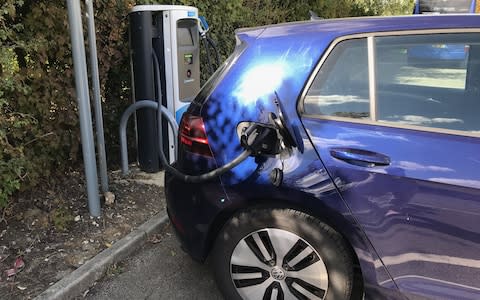
I couldn’t wait, so I decided to employ my back-up plan, the Chargemaster Polar charger at the Holiday Inn in Swindon, nine miles from Membury. (This is an important tip for budding or new EV drivers: always have a back-up charging plan.) The Polar wouldn’t work with my app, so it was a case of another charger, another helpline. I have a card, supplied by Volkswagen, but that doesn’t work, either: however, the operative on the phone could use the card number and manually start a charge, so after 45 minutes I was ready to go.
The Ecotricity charger at Cardiff Gate was my next stop. That didn’t work either, though. The Ecotricity staff member on the phone (and, as an aside, the quality of customer service from both Ecotricity and Polar was very good: polite and helpful) was apologetic, but the charger had been disconnected by engineers the night before, due to a problem. The charger at the next services, Sarn Park, about 20 miles away, was working, she said. So, with just 50 miles of range left, I took off.
With only 27 miles of range remaining, I arrived at Sarn Park and the charger was, thankfully, working. If it hadn’t, I would have been trouble.
I got to Llanelli in time, watched the match (a Scarlets win, to make it all worthwhile), stayed overnight at my parents’ house and headed home on Sunday morning with 80 miles of charge. Moto Services Swansea had a working Ecotricity charger – on free vend, too, so I didn’t have to pay – and that was enough to get me back to the Holiday Inn in Swindon, where the reinstalled Polar app worked.

My outbound trip took six-and-a-quarter hours (around two hours of which were taken up with charging, or trying to charge), with the return trip taking six hours (about 95 minutes of charging). My usual drive to Llanelli in an internal combustion-engined car takes three-and-a-half to four hours, so it’s almost comparable in an EV, even driving at 60-65mph to conserve energy on a couple of stretches.
So is the e-Golf a viable long-distance car? Yes – but the charging infrastructure, especially on the motorway network, which has to be close to infallible, is not yet reliable enough.
I know that the existing chargers aren’t exactly overused at the moment, but there have to be more of them at services, to ensure that there is always an alternative or a back-up. EV drivers can’t risk being left stranded at services, or have to divert off the motorway to charge, so the charger suppliers have to invest even more now, in advance of the uptake in EVs over the next few years (which is coming).
It was certainly a revealing trip, leaving me with lots to think about, some of which I’ll return to in future reports.
September 4, 2018
As befits running a battery-powered car, this week there’s one positive and one negative to report.
First, the positive. The one thing that you really notice in an EV is the instant access to some useful acceleration. OK, so the e-Golf only has a 0-62mph time of 9.6 seconds, which isn’t going to set the world alight, but the 0-100m speed is quicker than almost anything else on the road, short of a supercar using launch control function. This isn’t just about boy racer kudos, either: it’s a hugely practical in urban driving.
For example, I realised this week that a local road had its lane priority changed, so the inside lane of three at a set of traffic lights was now left-turn only a couple of hundred metres after the lights. Which meant that I was in the wrong lane to go straight ahead. Not a problem for the e-Golf, however: the lights went green, I floored the accelerator and the car moved swiftly and smoothly, allowing me to change lanes with plenty of space to spare.
The same is true of in-gear acceleration. As the e-Golf only has one gear, if a sudden burst of speed is required – to get ahead of another car when lanes are merging, perhaps – there’s nothing to beat it. No delay in the revs spooling up, no turbo lag, nothing other than a smooth, instant turn of speed.
So I have absolutely no issues with the e-Golf itself. The smartphone app however, continues to be a different story.
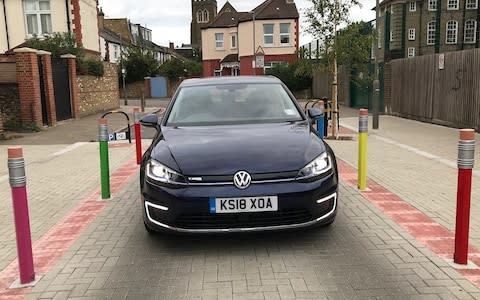
I wrote a few weeks ago about how poor the Car-Net app is and it continues to detract from the usership experience of the e-Golf.
Again, it has locked me out, but this time there are additional issues with connecting to a server and also telling me that my account doesn’t exist. This was inconvenient, as I was attempting to see if my car had finished charging at my local chargepoint.
As Source London continues to charge EV drivers for electricity even when their cars are fully charged, and therefore no longer actually consuming electricity, it's important to know when the battery is full, to avoid wasting money. Thanks to Car-Net app not working, I probably wasted a few quid – which isn’t a huge problem in the greater scheme of things, but is irritating nonetheless.
Of course, the Source London app should also be sophisticated enough to let the user know when their car is fully charged. Call me a cynic, but if they did that, they couldn’t continue overcharging EV drivers for electricity, so they have no incentive, I suppose.
It’s early days in the EV revolution, but if there’s one lesson that carmakers and charging suppliers can learn from us early adopters, it’s that if they’re going to develop apps for EV drivers these need to have the functionality and reliability to add something to the product or service on offer.
August 29, 2018

This week, I have been mostly running my battery down as low as I dare, in an attempt to cure myself of my range anxiety.
I managed to get down to single figures – eight miles, in fact – to see if I could continue to drive an EV as normal when there’s so little range left. I could – and I couldn’t.
With 20 miles remaining, my wife and I took a trip across south London to see an exhibition; a round trip of 10 miles. I drove relatively carefully, but not totally like a someone trying to preserve their battery. My wife was getting concerned, watching the range indicator count down, but I was confident that we could manage the 10-mile round trip with enough to spare. Which we did.
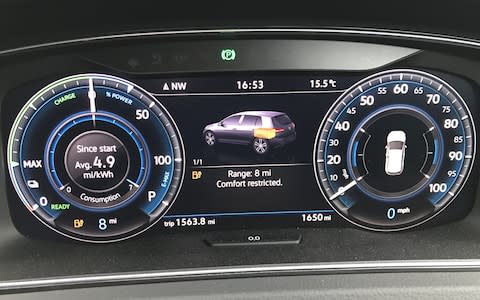
And although I drove the car as normal, the e-Golf took the executive decision to restrict the Comfort features, which meant that the air-con was out of bounds.
I was also curious to see how long it would take - and how much it would cost - to charge the battery from almost empty. The answer, on the Source London 7kW charger, is 288 minutes and £10.36.
That should give me around 120 miles of range. It's cheaper that filling with petrol or diesel, but not as cheap as it could be. I’d be curious to know how much it would be if I had a home charger and it was charged on my regular domestic electricity tariff.
I shall make some inquiries of other journalists running e-Golfs…
August 21, 2018
Two weeks on holiday in Portugal meant reacquainting myself with filling stations, which is odd after not having used such a thing for a few months. Plus I was driving a diesel with a manual gearbox, on undulating roads with roundabouts every few kilometres (so lots of gear changes), so it won’t come as surprise that I fell upon my e-Golf like a long-lost friend when we returned.
Because if anything convinces you of the joys of electric motoring, it's a couple of weeks away from it. You miss the almost-silent progress, the ease with which it handles almost every driving situation – and a special shout-out to traffic-light grands prix here, particularly when two lanes merge into one soon after – and the sense of calm.
My wife, who rarely comments on the many and varied cars I drive, is unusually vocal in her appreciation of the e-Golf. If her reaction is typical of how buyers will react when they first experience an electric car, the uptake in EVs over the next decade should increase as rapidly as industry analysts are predicting.
However, the apps developed by carmakers are going to have to keep pace with the developments in their electric powertrains.
I’ve already commented on my dissatisfaction with Volkswagen’s Car-Net app and while it generally works well, when it doesn’t it's a real pain. It struck again last week when, instead of just logging in with the Touch ID fingerprint sensor on my iPhone, it asked for a password. Remembering a password that you never use because you use your fingerprint is a challenge.
In addition, the app uses one of those random-letter-and-number Captcha systems, but it’s hidden under the keyboard that pops up to key in your password, so it's invisible and I was locked out; particularly annoying if you want to find out how the progress of your charging is going.
I can access my bank accounts using Touch ID, but for some reason that isn’t secure enough for Volkswagen. The company needs to sort that out, because it detracts from the ownership of a futuristic car.
July 24, 2018
A couple of months in with the Volkswagen e-Golf, it’s fair to say that I’m getting to grips with electric motoring and adapting how I drive.
So despite my range-anxious trip to the Cotswolds a few weeks ago, which necessitated driving on the motorway at 60mph, I’m largely driving the e-Golf as I would a car powered by an internal combustion engine (ICE).
Take Monday, for example. Another car launch involving a flight out of Farnborough, 40 miles from my home, meant an early-morning drive to Hampshire. And knowing that there were chargers at the airport meant that with 127 miles at the start, I could afford to drive at regular highway speeds.
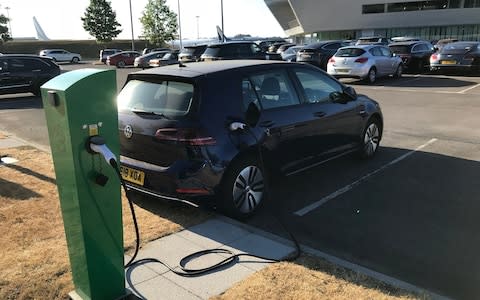
Sure enough, I managed to use 70 miles of range for the 40 miles, but I could charge the e-Golf while I was away (for free, unlike the public charging near my home) and I’d have a full battery for the return journey. As is necessary with an EV, I had a plan before my trip.
The only flaw comes if chargers don’t work - and that was nearly the case in this instance. I plugged into the same charger as I had on my last trip and... nothing. Luckily the terminal staff were able to discover that that particular charger seems to be a little temperamental and instead I used another, which worked perfectly.
Great, but before that solution I must admit to an anxious few minutes thinking about how 57 miles of range would get me home - which it would, just.
Tthat’s perhaps the lesson I’m taking from electric motoring: ditch the anxiety, drive like normal and something will turn up. As the proliferation of charging facilities continues to increase rapidly, this EV optimism should prove to be a justifiable approach.
Let’s just hope I haven’t jinxed myself now.
July 17, 2018
A relatively quiet week for the e-Golf, with just an(other) airport run and some local driving to run down the battery as low as I dare before charging it.
The airport run was for the launch of a new EV that has a 64kWh battery, which is almost twice the capacity of the 35.8kWh battery on the e-Golf. Those of us who drive the car can’t talk about it until next week (Telegraph readers will be able to get Andrew English’s review) because of an embargo, but suffice to say that a larger battery does seem to be the answer to range anxiety.
Personally, I haven’t been in any anxious about the e-Golf’s range, as I’ve decided to run the battery down as low as I possibly can, so I managed to get down to 17 miles of remaining range before taking it to my local charger. I would have gone lower, but I have to head into central London a couple of times in the next couple of days, so I thought I’d juice it up without risking the vagaries of public charging in the metropolis.
July 10, 2018
I love air-conditioning. Whether in hot offices, shops that offer a chilled respite from the stultifying heat of the city or in a car, air-con has always been my friend.
The problem is, despite us being in the grip of a heatwave, I feel as if I can’t use the air-con in the e-Golf. As soon as I turn it on, the range in the driver display plummets and my range anxiety overcomes my desire for that cold, sweet air and I turn it off, lowering the windows instead.
This is fine on the motorway, as you can get quite a breeze flowing through the car at 60/70mph, but it's less successful driving in towns – especially as the poor air quality in London that I’m attempting to play a small part in improving isn’t exactly conducive to windows-down motoring.

I will get braver and start using the e-Golf’s air-con but, knowing my luck, by then the heatwave will be over and I’ll be using the windscreen wipers more frequently.
Other than that, another airport run (this time to Farnborough) was accomplished relatively easily, in terms of range, but I was also able to charge there for free – which is always a plus and enabled me to not worry about going slowly to conserve range as I dashed home to catch Friday evening’s World Cup match.
I could even have switched on the air-con on, if I’d thought about it. Damn…
July 4, 2018
It’s been an interesting week in the e-Golf, as I went on my longest journey yet and discovered more about what it can do (and what it can’t).
On Thursday I drove to Tetbury, 109 miles from home. That didn’t give me a huge amount of leeway on the real-world 120-mile range. The car was almost fully charged, so I thought I should be able to get there, if I took it easy.
And take it easy I did. Once on the M4, I set the cruise control to 70mph and took my time.
By the time I reached Membury services, 30 miles or so from my destination, the difference in the available range and the distance to my destination was closing, so I thought I’d try the AC rapid charger at the services. Just as I parked, a message in the main touchscreen told me that I had insufficient charge to reach my destination.

I plugged in, fired up the app, chose the correct charger and… there was an error. The charger wasn’t working, so I had to use the next one – but that wasn’t rapid, just a regular DC charger, so I wouldn’t be able to get 80% of a full charge in 40 minutes.
I plugged in, had some breakfast, monitored the charging on the app and, after 40 minutes, had a relatively paltry extra 20 miles of range.
I made s l o w progress to my destination, with 20 miles to spare. Thankfully, I’d arranged to charge it at the hotel where I’d be based for the day, at a Tesla DC box, so I was able to start the return journey with a full charge.
I set the cruise control to 60mph - I don’t think I’ve ever driven at 60mph on a clear motorway before - but I made it home with 40 miles of range left and plugged it in at my regular charger near my home, so Thursday ended up being a three-charge day.

That first proper test of the Volkswagen’s range led me to an observation. The e-Golf is quick enough to cruise comfortably at motorway speeds: it’s also able to drive a distance in excess of the 120 miles that VW quotes (150 might even be possible). But you can’t have both at the same time – not at the moment, at least.
Battery technology and capacities should increase pretty rapidly in the next few years but Volkswagen, like other manufacturers, is still feeling its way and the e-Golf is at the start of what is so commonly called today ‘a journey’.
But after a month, I’m closer to understanding what the e-Golf’s limits are. My car usage is such that I won’t be testing those limits on a weekly basis but, when I do, I’m now better prepared.
June 26th, 2018
This week, I have mostly been sorting out technology failures. Such is the life of an early adopter.
The first was Apple CarPlay failing to work when I went to take 10 bags of hedge clippings to the local dump (don’t let anyone tell you an EV isn’t practical). Nothing would make it come alive on the way: stopping and switching off the ignition, stopping and locking the car and then unlocking it. Every variation of turning it off on and again failed to work. But after dumping my garden waste, I started the car and it suddenly worked.
I’ve previously encountered this on numerous occasions in several cars, so I think it’s an Apple bug, rather than a fault of car manufacturers. It's very annoying, all the same, as CarPlay is very handy for handsfree phone calls and sending/receiving texts.
The other failure was down to VW, though. While trying to check the status of my charging car on the Car-Net app on my phone, for some reason I couldn’t log in and ended up having to reset my password. I didn’t receive an email when I requested it, and that only happened when I tried again the following day.
We expect technology to just work, but the reality is that modern cars are incredibly complex machines. To put it in context, a modern car requires in excess of 100m lines of computer code to make everything work, while the Large Hadron Collider only needs 50 million.

So when the smartphone integration or an app that helps you to remotely control aspects of your car fail to work, it’s irritating, because we all have such high expectation of technology.
As the era of cars being defined by electrification, automation and connectivity looms large, our expectations are only going to increase. Car companies and technology providers are going to have to a long way to meet them – and the consequences of not meeting them could be a lot more serious than not being able to play your current favourite playlist.
In terms of how the e-Golf runs, I’m taking the view that I should just try and drive it as I would an internal combustion-engined car, as that’s what consumers switching to EVs will expect. So before a run to Heathrow last week, I charged the e-Golf fully (185 miles, which Volkswagen admits is a theoretical figure): however, my 45-mile round trip left me with 95-100 miles of range.
Admittedly, I’m not pussy-footing up and down the M4 between west London and the airport and, as I caught an early flight, leaving the house at 5.30am, I also had a pretty free run through town. But on the other hand, driving through more stop-start, inner-city traffic in the evening does end up being largely range-neutral, or only uses a fraction of the actual mileage.
But I’ve got a couple of longer trips coming up, so it's going to be interesting to see how my cavalier attitude works (or doesn’t) when faced with 100-mile journeys.
June 12th, 2018
“Are you an Uber?” Much as I joke about being a taxi driver for my kids, I’ve never before been mistaken for one of the ride-sharing private hire drivers that fill the streets of London of an evening.
I had taken a shortcut down a side road, only to be held up by an Uber driver double-parked in the middle of the road, folding down the third row of seats in a dirty old diesel MPV, with a group of young women waiting to get in to start their night out.
One came over to apologise to me for the delay, followed by the question about my status as a cab, probably prompted by the fact that I rolled up silently, much as a hybrid would.
The irony is, two days earlier, I’d been at an event organised by the Renewable Energy Association, where an Uber spokesman said that all the company’s cars would be fully electric by 2025. With Volkswagen’s plans for new EV models in the next few years, chances are that VWs could be part of that fleet.
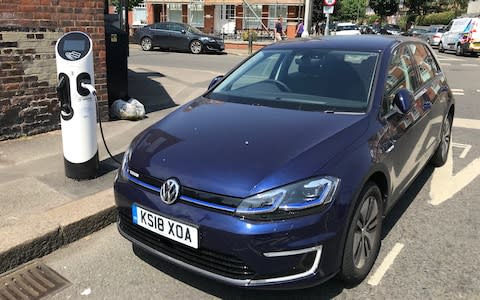
Anyway, the fact that there was a charger around the corner from my destination was perfect, as I was down to 18 miles of range and it meant that I could have a couple drinks, walk home, leave the car to charge overnight and then pick it up on Sunday morning. I suppose that’s what’s being called "destination charging" in EV-owning circles.
It was a good plan, which worked perfectly – apart from one detail that I’d overlooked. Source London, the charger provider, makes its customers pay for the time the car is plugged in, whether it is actually using electricity to charge or already achieved fully charged status.
OK, so the £19.11 I paid is a still a fraction of the cost of a fill-up in a combustion-engined car, but it’s still about £10-12 more than the cost of the actual electricity I needed.
I can understand the theory behind the policy: Source London wants EV drivers to charge and go, leaving the chargers free for other drivers.
That’s a perfectly sensible and reasonable policy if chargers are as in demand as they will be in 8 or 10 years, but the reality of here and now is that the banks of three chargers that I’m using in my area are hardly ever used: I’ve not seen another car charging at any of them in the last month – and I drive past them on a regular basis.
While it's not a huge amount of money, I still feel cheated that a charger supplier is making me pay for electricity I’m not using.
I’ll bet Uber drivers don’t have to put up with that.
June 5th, 2018
Range anxiety is, despite the claims of some smug Tesla drivers, a real thing.
When you know that you’ve got, at most, 120 miles before you need to find a publicly accessible charger to get some juice, you start to reappraise all kinds of things. Invitations to events, weekend trips – almost anything that requires you to drive beyond the bounds of the city – send you to Google Maps to work out the distance you need to travel, followed by a visit to the ZapMap website to check if there’s a (working) charger at your destination.
And it’s only by learning just what the e-Golf will do will I discover what journeys are possible – and which might just be a bridge too far.
So last week, being half-term, meant a trip to south Wales for a few days (grand)parent-wrangling. Discretion being the better part of a quiet life, I thought that including my wife and two teenagers as co-guinea pigs would be a bad move for a 200-mile EV run. But, I could still use the trip as a recce for future attempts, so every day would continue to be a school day.
Thankfully, Volkswagen was able to lend me a Tiguan Allspace for the trip, which, in 1.4 TSI guise was also a useful experiment, seeing how it would stack up against a diesel for a long trip (perfectly well, it turns out, especially with a six-speed DSG auto ’box). Yes, I’m privileged to be able to borrow other cars (as long as I’m able to write about them for one of my outlets), but in the short and medium terms, this is the kind of service that manufacturers of EVs might well be offering.
Indeed, Nissan Leaf owners have access to petrol or diesel vehicles from the Japanese carmaker’s range for 14 days over the first three years of ownership, while the new Care by Volvo service – a subscription package that involves monthly payments covering servicing insurance, concierge services et al – also means that plug-in hybrid Volvo users have access to other vehicles for 14 days a year.
Volkswagen doesn’t yet offer this kind of service to e-Golf owners, but when the company makes a big EV push in the next few years with its all-electric ID models, it won’t exactly be a massive a surprise if access to other, internal combustion-engined, vehicles for a limited period every year is part of the package.
This won’t be a long-term strategy, because hopefully within a decade there will be the kind of rapid-charging infrastructure in place (and greater battery capacities) to ensure that long trips don’t induce any sense of anxiety.

But in the meantime, my recce of what is a regular journey for me did nothing to assuage my range anxiety. Yes, the Ecotricity rapid chargers at services along the M4 should mean I can get to Llanelli with one stop, but I realised that the number of public chargers in the town is, er, one, which has recently been installed by Carmarthenshire County Council (there’s a Tesla charger at rugby stadium Parc y Scarlets, where I have season ticket, but that’s no good for my e-Golf). Relying on one charger being in operation and available is a tad risky, so let’s see how that works out.
In the meantime, my current in-town project is running the battery as low as I can risk it, in order to see exactly how long a full charge will take.
Can I get it down to single figures? That will certainly be a test of my anxiety threshold…
May 30th, 2018
And so the learning begins… I’ve been bimbling about around town, running errands, running the kids around, doing the shopping and so on, all the while trying to get my head around how the e-Golf uses the energy from the batteries – and how that relates to precisely how much range the readout in the instrumental panel is telling me I have.
We’ve had a few fairly hot days in the last week and on one recent trip I decided to use the air-conditioning – leaving the windows open isn’t great for my hay fever. I had a 148-mile range when I switched on the A/C’s Lo setting, which immediately lowered the range to 122 miles.
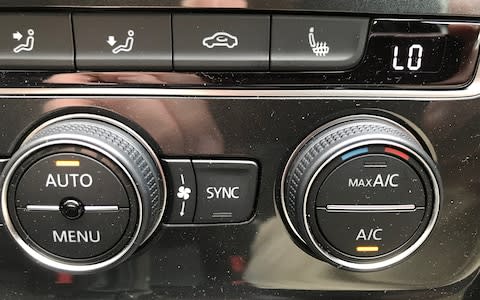
Suffice to say, I turned the temperature back up and restored my 148 miles. If it stays warm over the next few months, finding the balance between maximising the range and maintaining a cool cabin should be an interesting exercise.
As should driving on motorways. My first foray came last week, in the form of a quick trip to Gatwick. A relatively early morning trip through Croydon, then on to the M23, went well. The 23-mile journey used up 27 miles of range, which seemed pretty reasonable.
As I was returning later that evening, I used the valet service at the short-term parking and asked them to top up the charge (a service they offer). Armed with a 186-mile range for my drive home, and an appointment to make, I felt slightly emboldened and joined the M23 at the speed I would drive at in a conventional car.
The result? Let’s just say the range didn’t stay at 186 miles for long. I lost 50 miles instantly, so eased off and, by the time I left the motorway and started to drive through suburban Croydon, I was down to 123 miles. Driving most of the rest of the way home at 30mph meant that I managed to claw back another 9 miles and ended up at home with 133 miles on the readout.

A quick motorway jaunt, using 27 miles of range to Gatwick and 53 miles back was very instructive: I know I drove a little quicker at the start of my return journey, but not for long, so my process of e-driving trial and error is still very much in a nascent period.
And it doesn’t exactly fill me with optimism for trips to see my family in south Wales. But by the time the rugby season starts again in September, I should be sufficiently au fait with my range management that I can travel there with confidence to watch my beloved Scarlets.
May 24th, 2018
If buyers are going to adopt electric cars, some familiarity will be helpful. There’s almost nothing more familiar on the road than a Volkswagen Golf, so the e-Golf variant is the perfect vehicle in which to experience battery-powered daily driving.
I’ve been driving electric cars for years, but almost all my previous experiences have involved single test drives, after which I’ve been able to walk away, leaving someone else to worry about charging.
Living in a terraced south London house, with no off-street parking, borrowing one for a short-term loan from a manufacturer has always been tricky: I can’t trail a cable from my house across the pavement (a health and safety nightmare waiting to happen) and signing up to a public charging network requires opening an account, etc – which is way too much hassle for a week.
This has always irked me, because living in the metropolis makes me the ideal candidate to be a regular EV driver. Most of my journeys are around the capital, so while I want continued access to what’s increasingly being called a “personal mobility solution”, I also want to do my part to help improve the city’s environment (and its poor air quality).
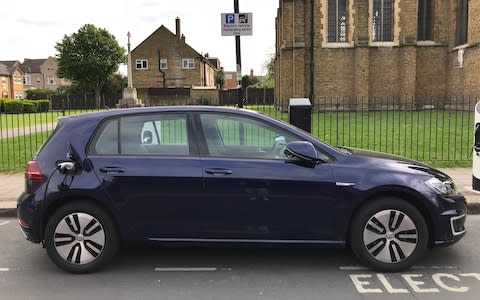
So I jumped at the chance to run a Volkswagen e-Golf, especially as my local council is starting to roll out more charging points – albeit slowly and in what seems a rather haphazard way (but that’s something I’ll no doubt return to weeks and months to come).
One week in, it is clear that there’s lots to work out about the logistics of running an EV, compared with one powered by an internal combustion engine. As Kyle Fortune has found during his long-term test of a BMW i3S, range anxiety is a real thing as long as a public charging infrastructure is still so sketchy – and it takes on new meaning when you’re already someone who gets twitchy when a fuel gauge drops below half-full.
Working out how to maximise the battery will be a fascinating exercise and one that I’m really looking forward to. And yes, I’m fully aware of how sad and nerdy that makes me sound.
Electric motoring is the future – but until that future arrives, a present in an e-Golf should make life interesting for the next few months.
For all the latest news, advice and reviews from Telegraph Cars, sign up to our weekly newsletter by entering your email here
More long-term tests


